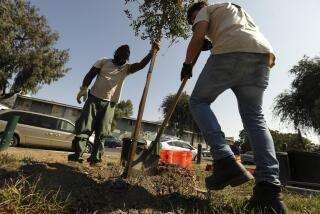Wilmington Woes to Get Closer Look in City Plan
WILMINGTON — Los Angeles officials are trying to devise a plan to help solve some of Wilmington’s problems by linking community activists with public and private resources, a city spokeswoman said last week.
The effort was initiated by City Councilwoman Joan Milke Flores in response to a series of stories that was published in October by The Times, said Rebecca Barrantes, an analyst for the office of the city’s chief administrative officer.
“We are looking at Wilmington and the problems brought out in the series,” Barrantes said Thursday. “We’ve also been trying to look at how other communities with similar problems have solved them.”
‘A Catalyst’
The Times articles detailed such problems as land-use conflicts, illegal dumping, commercial decline and school overcrowding, as well as the community’s fledgling efforts to bring attention to them.
Barrantes said the stories served as “a catalyst” for Flores’ action. “She realizes she has to do something about the problems.” Neither Flores, whose district includes Wilmington and surrounding areas, nor two of her aides returned phone calls seeking comment on the improvement effort. Flores was asked to comment for four other stories about Wilmington since the series appeared, but she did not return phone calls.
As part of the improvement effort, Barrantes said, the city may try to gather ideas from Wilmington residents about the community’s most pressing needs and present them in a “wish list” to private industry, nonprofit groups and government agencies. Similar efforts have been successful in other cities such as El Segundo, she said.
Cooperative Effort
Corporations in El Segundo have provided the community with amenities such as computer curriculums and educational equipment for the school district and repairs to vandalized Girl Scout facilities.
Stressing the importance of citizen involvement in Wilmington, Barrantes said that activists probably will be asked to help coordinate or lead the community improvement plan. Barrantes said Flores’ office also will play a large role in the effort and said she expects to meet with Flores this week to discuss the matter further.
“I think the main ingredient in this has to be a well-balanced, cooperative effort,” Barrantes said. “It should really be a coalition of resources coming together.” She said the resources would include money, professional expertise, equipment and other resident, government and business participation.
In addition, the office of the chief administrative officer, at Flores’ request, is trying to locate city money to launch a cleanup of littered areas and abandoned cars in Wilmington, said John Harris, senior administrative analyst. A recommendation for funding the cleanup is expected to be ready for City Council consideration by mid-February, Harris said. “There’s a lot trash and rubbish and clippings down there, stuff that’s been there for years,” Harris said. “It’s an eyesore and a health hazard and a general nuisance. . . . I don’t know of any other area of the city that is quite like that.”
The Times stories referred to by Barrantes told of a collection of problems that have afflicted Wilmington for decades. Although the community of 40,000 is situated in the heart of the country’s most profitable harbor and located atop the nation’s second-most-productive oil field, Wilmington reaps few benefits from its natural riches or from its estimated 800 to 900 community businesses.
Lack of Planning
Instead, Wilmington’s nine square miles contain an estimated 200 auto salvage yards, 13 closed waste dumps and 400 abandoned automobiles. Each of its seven public schools is overcrowded. Lack of planning has positioned dust-spewing industries next to residential neighborhoods. Litter clutters many of the community’s side streets.
Wilmington’s business district is withering; its homeless population is growing; its roads have deteriorated from heavy truck traffic.
These problems have become the focus of a collection of community activist efforts, each organized around a particular issue.
In addition to the newly announced city efforts, Flores, a second-term councilwoman who lives in nearby San Pedro, has in the last several months initiated:
- Consideration of a moratorium on the construction of high-density apartment complexes in Wilmington. Residents have protested such development, saying that services already are strained. They also say such projects should not be allowed because the community is being studied for widespread down-zoning. Flores is expected to make a decision on the proposed moratorium within two weeks.
- A task force composed of officials from the Port of Los Angeles, the Los Angeles Community Redevelopment Agency and the Los Angeles Planning Department to look into what the port can do to improve Wilmington. Flores has said she would like to see the port pay for recreation and commercial facilities in Wilmington, as it has done in San Pedro.
No Bradley Comment
Mayor Tom Bradley could not be reached for comment on the new city initiative. Despite repeated requests, he has been unavailable for an interview on Wilmington for the last five months.
In response to a request to discuss Wilmington’s problems at a Nov. 1 press conference at the Port of Los Angeles, Bradley described Wilmington’s concerns as irrelevant to the topic of discussion--increasing port profits and Bradley’s October trade mission to South America. At that time, Bradley pledged to arrange an interview with The Times to discuss the matter.
“As far as I know, the request (for an interview) has been presented to the mayor, but he hasn’t responded yet,” Bradley’s acting press secretary, Dee Dee Myers, said in an interview Thursday. “ . . . I’m sure he plans to eventually.”
More to Read
Sign up for Essential California
The most important California stories and recommendations in your inbox every morning.
You may occasionally receive promotional content from the Los Angeles Times.










